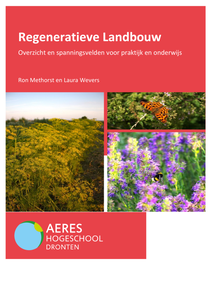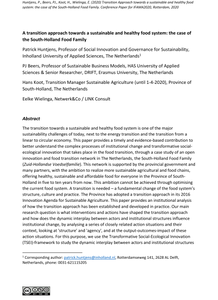Regenerative agriculture is increasingly seen as the way forward to safeguard soil fertility and with that economic, human and natural sustainability. The fashion industry, being very much reliant on inputs from the agricultural sector, can play a pivotal role in promoting regenerative practices. In order to do so however it needs to radically rethink its business model, or else it will not be able to reap all the possible benefits.
DOCUMENT

Presentation held at the National Conference ADT Baramati, India on the 6th February 2024
DOCUMENT

This open access book states that the endemic societal faultlines of our times are deeply intertwined and that they confront us with challenges affecting the security and sustainability of our societies. It states that new ways of inhabiting and cultivating our planet are needed to keep it healthy for future generations. This requires a fundamental shift from the current anthropocentric and economic growth-oriented social contract to a more ecocentric and regenerative natural social contract. The author posits that in a natural social contract, society cannot rely on the market or state alone for solutions to grand societal challenges, nor leave them to individual responsibility. Rather, these problems need to be solved through transformative social-ecological innovation (TSEI), which involves systemic changes that affect sustainability, health and justice. The TSEI framework presented in this book helps to diagnose and advance innovation and change across sectors and disciplines, and at different levels of governance. It identifies intervention points and helps formulate sustainable solutions for policymakers, administrators, concerned citizens and professionals in moving towards a more just and equitable society.
MULTIFILE

At the age of a failing economic system and undeniable evidence of the effects humankind has had over the planet, it is necessary to look for alternatives to the way we live locally. This article explores the use of designing narratives and metanarratives to co-create imaginaries serving as the needed alternatives. This research starts by considering the historical factors to understand how industrialisation and the loss of traditional practices created a culture of disconnection from Nature in the Girona area, but also looks at why people start now reconnecting with it. The analysis is the foundation for speculative design practices to co-create a new local narrative of connection and regeneration. The project adopted the Integrative Worldviews Framework and used paradoxes to create possible future worldviews based on historical factors and literature. Citizens participated in conversational future-visioning workshops to develop and evaluate their local imagery of the previously created worldviews. This conversation-based exercise evidenced the potential of paradoxes in destructive futures to create imaginaries of regeneration. These imaginaries merge and form future stories. From the future narratives, the practice created cultural artefacts embodying a new culture of connection based on storytelling, traditional jobs, and a mythological understanding of Nature. Finally, as observed at the end of the project, these artefacts allow citizens to adopt them as their culture and expand their current worldview.
DOCUMENT

This article provides a nano (hyperlocal) view of climate change mitigation by viewing regenerative organizing through the eyes (as well as bodies and senses, etc.) of the households engaged in community-based energy projects. By showing what humans make up for in the largely absent relationship between nature and technology in these projects, we envision an incremental extension of the literature on community-based energy. The radically different contribution we aim to make is a tripartite imbrication that brings in natural agency alongside the human and the technical but specifies precisely how nano (smaller than micro) embodied practices afford mis- and realignments. https://doi.org/10.1177/1086026619886841 LinkedIn: https://www.linkedin.com/in/helenkopnina/
MULTIFILE

Dit rapport verkent hoe de nog onduidelijk gedefinieerde term regeneratieve landbouw zich verhoudt tot bredere discussies over duurzame landbouw. Het schetst spanningsvelden rond definities (proces - versus resultaatgericht), discours (regeneratief ↔ industrieel-productivistisch) en sociaal-economische context. Centraal staat het streven naar voortdurende vernieuwing van landbouwsystemen door herstel van bodemgezondheid, versterking van biodiversiteit en verbetering van ecosysteemdiensten, vaak gezien als 'een stap verder dan duurzame landbouw'. Daarnaast laat het document zien dat uiteenlopende stakeholders – van onderwijsinstellingen tot multinationals – verschillende accenten en belangen hebben, wat kan leiden tot verwarring, maar ook tot kansen voor dialoog in praktijk en onderwijs.
DOCUMENT

The transition towards a sustainable and healthy food system is one of the major sustainability challenges of today, next to the energy transition and the transition from a linear to circular economy. This paper provides a timely and evidence-based contribution to better understand the complex processes of institutional change and transformative social-ecological innovation that takes place in the food transition, through a case study of an open innovation and food transition network in The Netherlands, the South-Holland Food Family (Zuid-Hollandse Voedselfamilie). This network is supported by the provincial government and many partners, with the ambition to realize more sustainable agricultural and food chains, offering healthy, sustainable and affordable food for everyone in the Province of South-Holland in five to ten years from now. This ambition cannot be achieved through optimising the current food system. A transition is needed – a fundamental change of the food system’s structure, culture and practice. The Province has adopted a transition approach in its 2016 Innovation Agenda for Sustainable Agriculture. This paper provides an institutional analysis of how the transition approach has been established and developed in practice. Our main research question is what interventions and actions have shaped the transition approach and how does the dynamic interplay between actors and institutional structures influence institutional change, by analysing a series of closely related action situations and their context, looking at 'structure' and 'agency', and at the output-outcomes-impact of these action situations. For this purpose, we use the Transformative Social-Ecological Innovation (TSEI)-framework to study the dynamic interplay between actors and institutional structures influencing institutional change. The example of TSEI-framework application in this paper shows when and how local agents change the institutional context itself, which provides relevant insights on institutional work and the mutually constitutive nature of structure and agency. Above institutional analysis also shows the pivotal role of a number of actors, such as network facilitators and provincial minister, and their capability and skills to combine formal and informal institutional environments and logics and mobilize resources, thereby legitimizing and supporting the change effort. The results are indicative of the importance of institutional structures as both facilitating (i.e., the province’s policies) and limiting (e.g. land ownership) transition dynamics.
DOCUMENT

In human-controlled environments and in cultivated landscapes, the plants accommodate social, cultural and economic needs. This article will focus on the use of plants for agriculture, urban planning, forestry, environmental education and indoor decoration in The Netherlands. This exploration, based on literature review and observations, reveals mostly anthropocentric, instrumental and unsustainable practices. In urban landscapes, plants are pushed to the margins, if not entirely eradicated. This article shows that the moral recognition of plants is an ethical imperative, which is also critically important in order to achieve environmental sustainability. In line with ecocentric ethics and in the interest of long-term sustainability, this article suggests an alternative, more ethical and sustainable ways of relating to plants in The Netherlands and beyond. This is an Accepted Manuscript of an article published by Taylor & Francis in "Journal of Urbanism: International Research on Placemaking and Urban Sustainability" on 10/11/18 available online: https://doi.org/10.1080/17549175.2018.1527780 LinkedIn: https://www.linkedin.com/in/helenkopnina/
MULTIFILE
